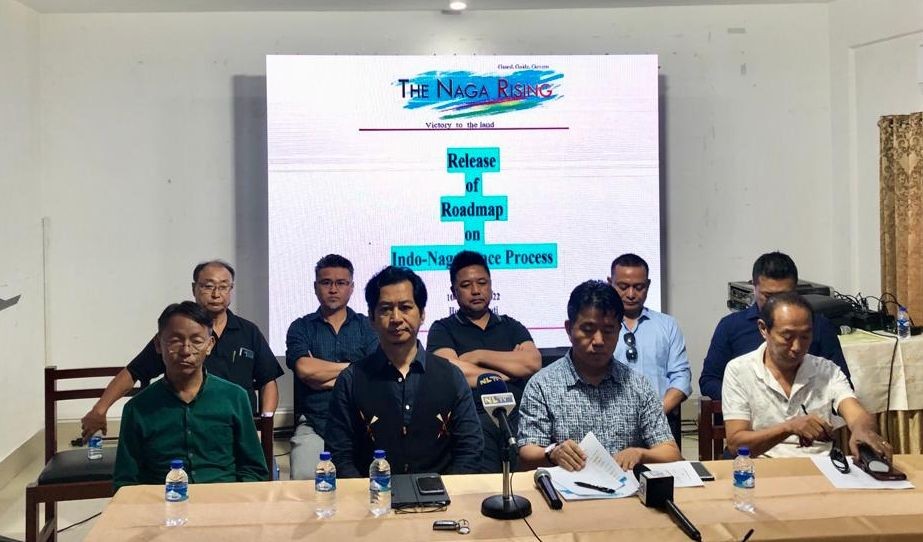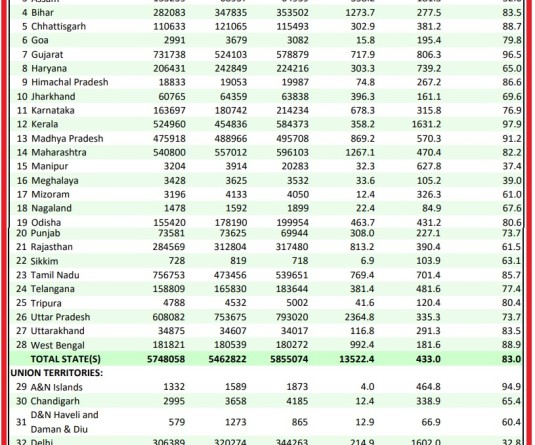Members of The Naga Rising address the media after unveiling the ‘Roadmap to a peaceful, honourable and early solution’ to Naga political issue at Hotel Saramati on August 10. (Morung Photo)

Morung Express News
Dimapur | August 10
A Church-initiated community platform, convergence of the Naga Political Groups (NPGs) and breaking stalemate between the Government of India (GoI)and NSCN (IM) were the 3-point proposal The Naga Rising (TNR) presented on August 10 in its “Roadmap to a peaceful, honourable and early solution,’ to the vexed Naga political issue.

Releasing the ‘Roadmap’ before the media here at Hotel Saramati, Convenor Along Longkumer expressed the TNR’s firm belief that the ‘Roadmap’ presents a “rational plan of action to reach a definite conclusion or goal …of what all Nagas want…peaceful, honorable and early solution….”
The TNR, he said, is putting up the Roadmap in the public domain for the Naga citizens to take common ownership and to help realise the 3-Point proposal.
The first proposal is for the formation of a ‘Community Platform’ with representation of “all shades and opinions” of Naga-land and initiated by the Church.
This platform should be borderless, a TNR member elaborated, while interacting with the media after the formal release, further informing that the Roadmap would be taken to various stakeholders of the Naga political process.
The Naga Rising Convenor, Along Longkumer unveils the ‘Roadmap to a peaceful, honourable and early solution’ to Naga political issue at Hotel Saramati on August 10. (Morung Photo)
It would help supplement efforts of the Core Committee on Naga Political Issue comprising all 60 legislators of Nagaland, the Roadmap reads.
Working towards ‘Convergence’ of the NPGs is the second proposal, based on the resolution passed at its annual meeting on June 29, 2022. According to the TNR, this is imperative as the GoI has announced that “there will be only one solution to the Naga issue.”
The third proposal contained in the ‘Roadmap’ is to help-break the ‘Stalemate’ between GoI and NSCN (IM) on the “unresolved issue of flag and constitution.”
Queried on the way forward to break the stalemate, a member further informed that TNR’s initiative is underway, and while a final blueprint is yet to be in public domain, it is already expounded on the issue last month.
In must be mentioned here that the TNR via a media release on July 14, informed that it tapped into “rich knowledge and experiences of experts/thinkers” on “fresh ideas on the way forward for the peace process ranging from the Naga flag, the Naga constitution, the notion of shared sovereignty and the question of Naga-inhabited areas.”
Rationale for Roadmap
Elaborating on the rationale and the basis for the roadmap, TNR Convenor Along pointed out that fixing the Naga political issue is needed to tackle the complexity of the present Naga situation.
It requires collective priority, attention and unified action, he said, adding that the Naga public has “become restless and they are losing faith in the long drawn peace process of 25 years.”
And therefore this roadmap, he stated, although insisting that few things should be “made clear” before reading into it.
It is not a unilateral document to benefit “only one side, party or faction,” he asserted, but a “unifying draft that can have a positive impact on the present peace process."
Again, the TNR initiative should be seen as complementary, not contradictory, to the resolve of the Naga public for early and inclusive solution, he added.
“We acknowledge, support and respect the different public movement…platforms and voices working for the resolution of the Naga political issue,” the Convenor affirmed.
However, the TNR is very “clear and firm in our understanding” that beyond making appeals for early solution or mobilizing the masses, the prevailing situation also demands a decisive plan of combined action and strategy, he added.
Along further pointed out that Naga by nature can be “emotional and impulsive” in a given situation and consequently tend to lose their way in the confusion and create isms and divisions.
“We need to apply more of our mind …to think critically and objectively,” implying that the ‘Roadmap” is one such steps, though it has an emotional appeal to it.
TNR further noted that it values and supports the resolve of the Naga public for early solution to the 25-year long peace process and recognise the moral responsibility of all Nagas to work collectively and prepare ground for political solution.
However, expressing concern over unhelpful deep division prevailing in the present Naga society, it stated that the way forward is for all Nagas to work together in the interest of early and peaceful solution.
Accordingly, the Roadmap was proposed.
Why TNR?
With the motto, ‘Guide Guard and Govern,’ TNR was formed in part of 2019 with the broad objective to engage in a wide range of issues and concerns facing the Naga community and self-described itself to be a platform that “seeks to bring people and issues together” and be a “catalyst for reform and problem solving.”
One primary motivation for the embarking on the journey is to build a better world and future our children and the younger generation, the Convenor said.
It is deeply-rooted in the Naga people’s collective story of faith, freedom and fraternity, he added, particularly the 1929 Naga Memorandum to the Simon Commission as a ‘guiding light.’
Germinating from the seed planted on the ground a long time ago through initiatives of our Naga elders and pioneers, but renewing the vision with the notion that a new thinking is required in tune with the present context and times, the TNR was formed, he stated.
A political party - Rising People’s Party, was also formed to act as the ‘catalyst for change,’ among others.





